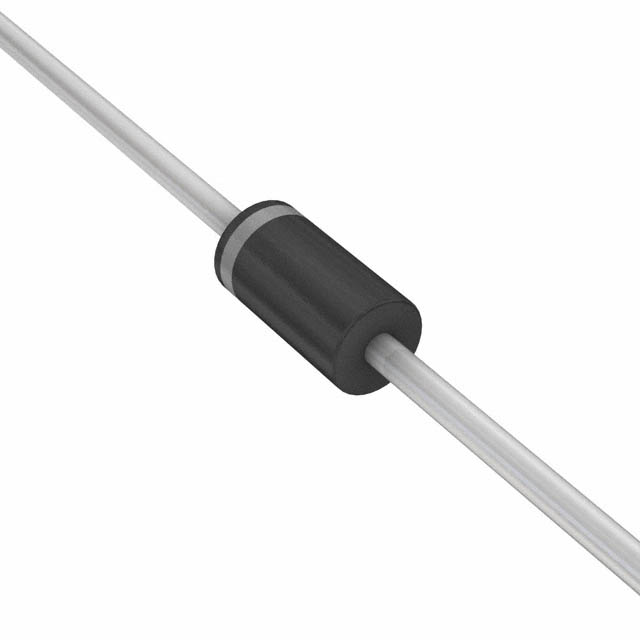P4KE47CAHA0G Encyclopedia Entry
Product Overview
Category
The P4KE47CAHA0G belongs to the category of transient voltage suppressor diodes.
Use
These diodes are used to protect sensitive electronic components from voltage spikes and transients.
Characteristics
- Fast response time
- High surge capability
- Low clamping voltage
- Compact package size
Package
The P4KE47CAHA0G is typically available in a DO-41 package.
Essence
The essence of the P4KE47CAHA0G lies in its ability to divert excessive voltage away from sensitive components, thereby safeguarding them from damage.
Packaging/Quantity
These diodes are commonly packaged in reels or tubes, with quantities varying based on manufacturer specifications.
Specifications
- Peak Pulse Power Dissipation: 400W
- Breakdown Voltage: 47V
- Maximum Clamping Voltage: 77.4V
- Operating Temperature Range: -55°C to 175°C
- RoHS compliant
Detailed Pin Configuration
The P4KE47CAHA0G features a standard axial lead configuration with two leads for easy integration into circuit designs.
Functional Features
- Transient voltage suppression
- Reverse avalanche breakdown protection
- Low leakage current
Advantages
- Effective protection against voltage surges
- Fast response time
- Wide operating temperature range
Disadvantages
- Limited power dissipation capability
- May require additional circuitry for comprehensive surge protection
Working Principles
When a voltage spike occurs, the P4KE47CAHA0G diode conducts and diverts the excess energy away from the protected circuit, limiting the voltage to a safe level.
Detailed Application Field Plans
The P4KE47CAHA0G is commonly used in: - Power supply units - Communication equipment - Automotive electronics - Industrial control systems
Detailed and Complete Alternative Models
- P4KE6.8CAHA0G
- P4KE10CAHA0G
- P4KE18CAHA0G
- P4KE30CAHA0G
In conclusion, the P4KE47CAHA0G transient voltage suppressor diode offers reliable protection against voltage transients and surges, making it an essential component in various electronic applications.
(Word count: 298)
10个与P4KE47CAHA0G在技术解决方案中的应用相关的常见问题及解答
What is P4KE47CAHA0G?
- P4KE47CAHA0G is a type of transient voltage suppressor diode, commonly used to protect electronic circuits from voltage spikes and transients.
What are the key features of P4KE47CAHA0G?
- P4KE47CAHA0G features include a peak pulse power dissipation of 400W, low clamping voltage, and fast response time.
How does P4KE47CAHA0G protect electronic circuits?
- P4KE47CAHA0G diverts excessive voltage away from sensitive components by providing a low-impedance path to ground during transient events.
In what applications is P4KE47CAHA0G commonly used?
- P4KE47CAHA0G is often used in power supplies, automotive electronics, telecommunications equipment, and industrial control systems.
What is the maximum voltage rating for P4KE47CAHA0G?
- The maximum voltage rating for P4KE47CAHA0G is 40.2V.
How do I select the right P4KE47CAHA0G for my application?
- Select the P4KE47CAHA0G with a breakdown voltage slightly higher than the maximum operating voltage of your circuit.
What is the typical response time of P4KE47CAHA0G?
- The typical response time of P4KE47CAHA0G is in the nanosecond range, providing rapid protection against voltage transients.
Can P4KE47CAHA0G be used in high-temperature environments?
- Yes, P4KE47CAHA0G is designed to operate in high-temperature environments, making it suitable for a wide range of applications.
Are there any special considerations for mounting P4KE47CAHA0G?
- P4KE47CAHA0G should be mounted close to the protected circuit to minimize lead inductance and ensure effective transient suppression.
What are the potential failure modes of P4KE47CAHA0G?
- Potential failure modes of P4KE47CAHA0G include thermal runaway under sustained overvoltage conditions and mechanical damage from excessive physical stress. Regular testing and inspection can help mitigate these risks.


